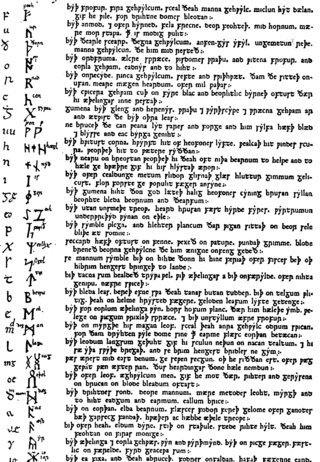
A rune is a letter in a set of related alphabets known as runic alphabets native to the Germanic peoples. Runes were used to write various Germanic languages before they adopted the Latin alphabet, and for specialised purposes thereafter. In addition to representing a sound value, runes can be used to represent the concepts after which they are named (ideographs). Scholars refer to instances of the latter as Begriffsrunen. The Scandinavian variants are also known as futhark or fuþark ; the Anglo-Saxon variant is futhorc or fuþorc.
Rune poems are poems that list the letters of runic alphabets while providing an explanatory poetic stanza for each letter. Three different poems have been preserved: the Anglo-Saxon Rune Poem, the Norwegian Rune Poem, and the Icelandic Rune Poem.
ᛈ is the rune denoting the sound p in the Elder Futhark runic alphabet. It does not appear in the Younger Futhark. It is named peorð in the Anglo-Saxon rune-poem and glossed enigmatically as follows:
The Younger Futhark, also called Scandinavian runes, is a runic alphabet and a reduced form of the Elder Futhark, with only 16 characters, in use from about the 9th century, after a "transitional period" during the 7th and 8th centuries. The reduction, somewhat paradoxically, happened at the same time as phonetic changes that led to a greater number of different phonemes in the spoken language, when Proto-Norse evolved into Old Norse. Also, the writing custom avoided carving the same rune consecutively for the same sound, so the spoken distinction between long and short vowels was lost in writing. Thus, the language included distinct sounds and minimal pairs that were written the same.

The Elder Futhark, also known as the Older Futhark, Old Futhark, or Germanic Futhark, is the oldest form of the runic alphabets. It was a writing system used by Germanic peoples for Northwest Germanic dialects in the Migration Period. Inscriptions are found on artifacts including jewelry, amulets, plateware, tools, and weapons, as well as runestones in Scandinavia, from the 2nd to the 10th centuries.
The Fehu rune ᚠ represents the f and v-sound in the Younger Futhark and Futhorc alphabets. Its name means '(mobile) wealth', cognate to English fee with the original meaning of 'sheep' or 'cattle'. The Proto-Germanic name *fehu has been reconstructed, with the meaning of "money, cattle, wealth".

The k-rune ᚲ is called Kaun in both the Norwegian and Icelandic rune poems, meaning "ulcer". The reconstructed Proto-Germanic name is *Kauną. It is also known as Kenaz ("torch"), based on its Anglo-Saxon name.
Algiz is the name conventionally given to the "z-rune" ᛉ of the Elder Futhark runic alphabet. Its transliteration is z, understood as a phoneme of the Proto-Germanic language, the terminal *z continuing Proto-Indo-European terminal *s.
*Raidō "ride, journey" is the reconstructed Proto-Germanic name of the r- rune of the Elder Futhark ᚱ. The name is attested for the same rune in all three rune poems, Old Norwegian Ræið Icelandic Reið, Anglo-Saxon Rad, as well as for the corresponding letter of the Gothic alphabet 𐍂 r, called raida. The shape of the rune may be directly derived from Latin R.
Jera is the conventional name of the j-rune ᛃ of the Elder Futhark, from a reconstructed Common Germanic stem *jēra- meaning "harvest, (good) year".
*Ehwaz is the reconstructed Proto-Germanic name of the Elder Futhark e rune ᛖ, meaning "horse". In the Anglo-Saxon futhorc, it is continued as ᛖeh.
*Laguz or *Laukaz is the reconstructed Proto-Germanic name of the l-rune ᛚ, *laguz meaning "water" or "lake" and *laukaz meaning "leek". In the Anglo-Saxon rune poem, it is called lagu "ocean". In the Younger Futhark, the rune is called lögr "waterfall" in Icelandic and logr "water" in Norse.

Anglo-Saxon runes are runes used by the early Anglo-Saxons as an alphabet in their writing system. The characters are known collectively as the futhorc from the Old English sound values of the first six runes. The futhorc was a development from the 24-character Elder Futhark. Since the futhorc runes are thought to have first been used in Frisia before the Anglo-Saxon settlement of Britain, they have also been called Anglo-Frisian runes. They were likely to have been used from the 5th century onward, recording Old English and Old Frisian.
The rune ᚦ is called Thurs in the Icelandic and Norwegian rune poems. In the Anglo-Saxon rune poem it is called thorn, whence the name of the letter þ derived. It is transliterated as þ, and has the sound value of a voiceless dental fricative.
A runic inscription is an inscription made in one of the various runic alphabets. They generally contained practical information or memorials instead of magic or mythic stories. The body of runic inscriptions falls into the three categories of Elder Futhark, Anglo-Frisian Futhorc and Younger Futhark.
Ansuz is the conventional name given to the a-rune of the Elder Futhark, ᚨ. The name is based on Proto-Germanic *ansuz, denoting a deity belonging to the principal pantheon in Germanic paganism.

The spear or lance, together with the bow, the sword, the seax and the shield, was the main equipment of the Germanic warriors during the Migration Period and the Early Middle Ages.
Sowilo (*sōwilō), meaning "sun", is the reconstructed Proto-Germanic language name of the s-rune.

The Old English rune poem, dated to the 8th or 9th century, has stanzas on 29 Anglo-Saxon runes. It stands alongside younger rune poems from Scandinavia, which record the names of the 16 Younger Futhark runes.
Runic alphabets have seen numerous uses since the 18th-century Viking revival, in Scandinavian Romantic nationalism (Gothicismus) and Germanic occultism in the 19th century, and in the context of the Fantasy genre and of Germanic Neopaganism in the 20th century.
![]() /𐌗 had a value of [s]).
/𐌗 had a value of [s]).




